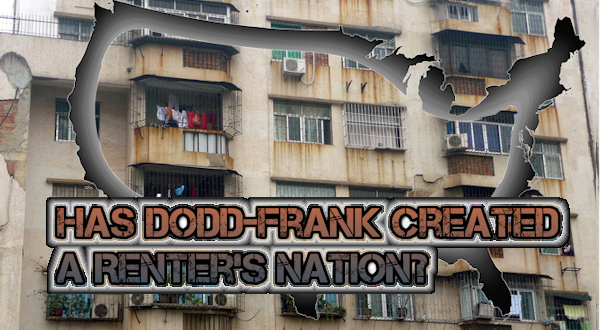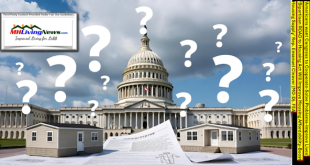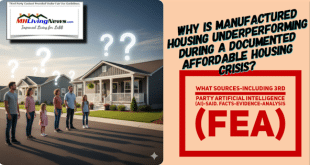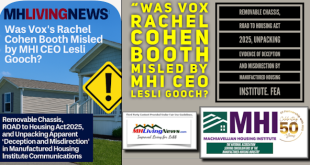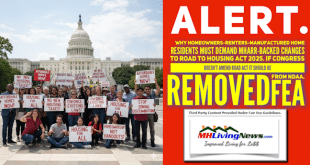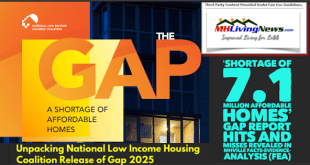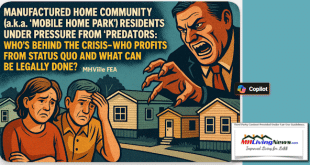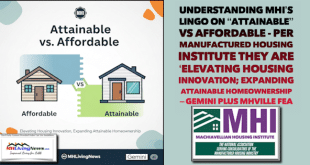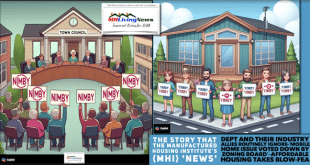New Federal regulations, enacted in the wake of the subprime mortgage crisis, are playing a key role in establishing a class of lifetime renters — all in the name of consumer protection.
By Jan Hollingsworth
for MHLivingNews.com
The old man walked into the dealership in rural Kentucky with solid credit and the air of someone who knew exactly what he wanted.
He wore the uniform of a local farmer — bib overalls, with a pinch of chewing tobacco tucked in one cheek. He didn’t speak the King’s English, but what he might have lacked in formal education, he more than made up for in intent: He had come to buy a new manufactured home.
The man spent two hours browsing through models and weighing the many options. This was an important decision — and likely the biggest purchase he would ever make.
Finally, he was ready to get down to business. The salesman handed him an application. The old man barely glanced at it and asked for help filling it out.
“I’m sorry, but I can’t do that,” the salesman told him, then explained that new federal regulations prohibited manufactured home retailers from helping customers apply for financing.
The old man might have been illiterate; he may have forgotten his reading glasses. Maybe he just hated filling out forms.
For whatever reason, he seemed deeply offended — and perhaps embarrassed.
“If you’re not going to help me, I’m not buying from you,” he told the salesman as he stormed out the door.
Everyone lost on that one:
- The salesman who stood to earn a commission.
- The man who found the home of his dreams — only to lose his dignity in the process.
- And the industry that is struggling to recover from the greatest financial housing crisis since The Great Depression, now burdened with mystifying regulations that no one seems able to explain.
“He wasn’t asking the salesman to do anything that a real estate agent doesn’t do every day,” says Barry Noffsinger, a regional manager for CU Factory Built Lending, one of the nation’s leading MH lenders, who witnessed the frustrating exchange. “It just makes no sense at all.”
The Alternate Universe of Dodd-Frank
Regulations have always been a fact of life for those who build, sell and finance manufactured homes, but the Dodd-Frank Wall Street Reform and Consumer Protection Act — passed in 2010 to address the subprime mortgage crisis — has turned the industry on its head.

“Our compliance costs have quadrupled in the past three years alone,” says Don Glisson, CEO of Triad Financial Services, another leading MH lender in the “A” credit market for more than half a century. Triad and CU Factory Built rank third and fourth in the MH finance market for buyers with FICO scores above 650.
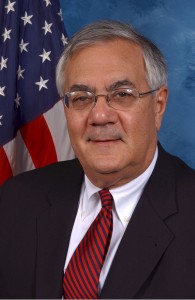
The sweeping 2,000-page Dodd-Frank regulations were never meant to apply to factory-built homes at all, according to a letter written by the law’s co-sponsor, Barney Frank. Nevertheless, industry professionals say MH financing has been so profoundly impacted, it is hurting the people who can least afford it — low- to moderate-income buyers trying to make the transition from renting to owning their own homes.
At a time when consumer interest in manufactured homes from all sectors — young, old, rich, poor — is trending upward, buyers and sellers find themselves with limited access to financing.
Dodd-Frank rules have driven many small banks, credit unions and other MH lenders out of the business. Those that remain are making fewer loans than prior to the 2008 mortgage meltdown. Prospective buyers are forced to choose between mega-interest personal loans to buy a home, or to continue treading water in the rental market.

That’s what happened to Eric Powell, a Louisiana father of three with a near-700 FICO score, who was unable to find an MH lender willing to finance a modest $7500 used manufactured home on land that had been in his family for generations.
One of the unintended consequences of Dodd-Frank has all but shut down financing for homes priced below $20,000. That left Powell with a Hobson’s choice: Continue to rent an apartment indefinitely, as he had for the past 10 years, or take out an unsecured personal loan from a non-MH lender at 36 percent interest to purchase a home he could call his own in less than five years.
“Our desire to buy the home outweighed our desire to not pay 36 percent interest,” Powell says. Even at that rate, Powell’s payment was less than half what apartment rent would have cost him.
No Explanation
Another Dodd-Frank obstacle in the path to home ownership is a rule that prevents an MH retailer from advising customers about finance options unless they become a licensed Mortgage Loan Originator (MLO) — a certification that requires coursework and a test that has nothing to do with manufactured homes or the type of personal property loans that are used by most sellers to finance them.
“This would be like going to a car dealer to buy a new SUV, and when you ask for help securing a loan, they hand you the phone book and say they can’t help you, so just pick one out yourself,” says Triad’s Glisson.
The MLO rule, enacted by the federal agency that was created and empowered by Dodd-Frank, was meant to address “steering,” one facet of the 2008 housing crisis, in which lenders nudged borrowers with little financial experience toward high-interest subprime loans in exchange for exorbitant commissions or “kick-backs.”
Although the illegal steering activity of the subprime crisis, like the MLO certification, has nothing to do with manufactured housing, the federal Consumer Finance Protection Bureau (CFPB) singled out the industry for special restrictions.

“Realtors refer customers every day to lenders, but CFPB says they’re exempt, because they’re not being compensated. But our people aren’t either,” says MH finance consultant Dick Ernst, president of Financial Marketing Associates, Inc.
CFPB either cannot or will not explain the rationale.
Ernst, Noffsinger and other lenders in the MH market met with CFPB staff to discuss the impact of the rules on both the industry and prospective homeowners, but left without answers or remedies, which Congress had empowered the agency in 2010 to devise.

Presented with a list of questions asking for the reasoning behind the CFPB-imposed rules — why they have been applied to manufactured housing and whether the agency is aware of their impact on consumers — CFPB spokesman Sam Gilford cited excerpts from the Dodd-Frank Act, itself, but did not directly address the issues raised.
Dodd-Frank has a very broad definition for loan originators, with some exclusions, Gilford notes. “One of these is a limited exclusion for employees of manufactured housing retailers that permits them to conduct certain activities without being treated as loan originators.”
But none of those activities allow a salesman to help a buyer fill out an application, or perform any of the functions routinely provided by Realtors.
“We think it’s very, very discriminatory to the industry, and it hurts the consumers,” says Ernst. “They go to banks and find out they don’t do MH loans.”
And if prospective buyers do, by chance stumble upon someone who will finance a manufactured home, they may not qualify for a loan from that particular lender.
Industry leaders suggest there is a big difference between “steering” people to high-cost loans for kick-backs — a practice that contributed to massive foreclosures in the 2008 meltdown of the traditional housing market — and simply pointing someone in an intelligent direction to pursue financing.
“Why have them apply to three lenders that will reject them outright, when there’s only one that would approve them?” Ernst asks.
Flying Solo, Bailing Out
The financial landscape is difficult enough for consumers to navigate in the realm of traditional mortgages, which the average person might explore every 7 to 10 years or so.
Traditional mortgages are available to buyers of manufactured homes as well, but two out of three are financed through so-called “chattel” loans that are secured by the home only, since the land it occupies is often in a land-lease community, or on a rural parcel that the potential buyer already owns.
The chattel – or personal property, home only – loan market was hardest hit by the Dodd-Frank rules, with often dire consequences for buyers, sellers and the industry as a whole.
Few MH retailers do enough business to justify the expense of keeping an MLO-licensed sales person on staff and without one, customers are left to their own devices in terms of seeking financing.
“We can’t say anything unless we’re licensed MLOs,” Ernst says. “Anything meaningful, in terms of helping the consumer, we can’t do.”
Instead, applications that prospective buyers fill out are shot-gunned to every potential lender, regardless of the company’s requirements and underwriting standards.
“In the past, a retailer could pre-qualify a buyer by accessing their credit reports and analyzing their income — just like every Realtor ® in America does — and with that info they could at least determine what lender not to send the application to,” says Glisson.
Beginning in 2014, when the MLO rule went into effect, Triad had to add several employees to handle the crush of applicants that had no chance of qualifying for a loan, he says.
“Our origination cost per loan has skyrocketed. Pre-2014, we would approve about 50 percent of the applications we received, as they were pre-screened. Currently we approve about 30 percent … so our efficiency went down the tubes and we are working harder and spending more to make the same amount of loans.”
That, in turn, has driven up the cost of lending money and someone — often the consumers who can least afford it — must pay.
The fact that Realtors ® routinely help their clients negotiate financing options when purchasing a site-built home, free of MLO restrictions, underscores the impact Dodd-Frank has had on MH buyers, says Glisson.
“Because they are flying solo, they might just go to the first lender that pops up on a Google search, which might not be the best-priced option for them.”
That is exactly how Eric Powell ended up with a 36 percent interest personal loan from a non-MH lender. There was no one to advise him where to find MH lenders who might qualify him for a chattel loan at 12 or 13 percent, or less.

significantly
“I understand the anti-steering issue and agree that the customer should be presented with all the options, not just the one that benefits the retailer and his parent company,” Glisson says. “But not being able to show the customer any options is a disservice to the home buyer.”
Many prospective buyers are not as determined as Powell to find a path to home ownership.
Giving Up the Dream
Set adrift by the Dodd-Frank rules, they become discouraged after being turned down again and again by lenders that don’t make home-only loans, or whose underwriting standards aren’t a good match.
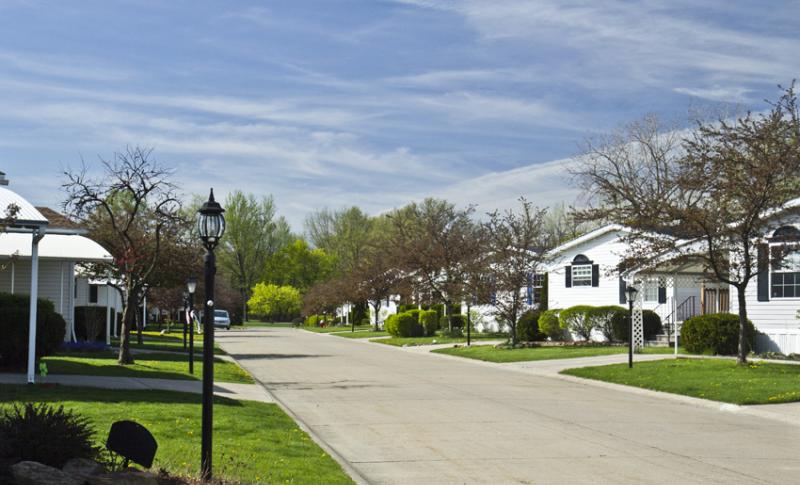
Joseph Ravanelli had his heart set on a furnished, move-in-ready manufactured home in Twin Oaks, an upscale MH community in North Ridgeville, Ohio.
Ravanelli says he had already been pre-approved for financing $100,000 on a single-family home, but decided that wasn’t the lifestyle he had in mind.
He wanted to downsize — no yard, no maintenance, just a “real, real nice park” with gym, pool, and security. And at $40,000, getting financing would be a slam dunk — or so he thought.
“We called the banks and credit unions and none do manufactured housing loans. It was like a needle in a haystack, so we just gave up,” he says.
So, Joseph Ravenelli — would-be homeowner — remains a renter, paying nearly $200 a month more to live in a home he will never own, than his dream home in Twin Oaks would have cost.
He is among tens of thousands of prospective MH owners who will continue to rent due to regulatory risks and costs that have cut off financing options — an unintended consequence of rules imposed in the name of consumer protection.
There is the daycare operator who was trying to buy the manufactured home she’s been renting for some time; the registered nurse who would save nearly $500 a month, if only he could buy the MH he’s currently renting; the night shift supervisor who could move closer to his work and his son’s school, saving more than $900 a month over what it now costs him to rent a site-built home.
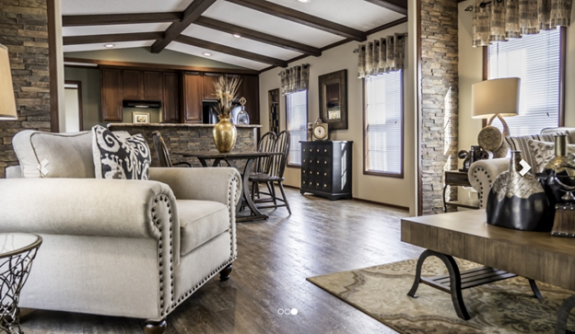
The list goes on. All have one thing in common: They want to own a home and they likely could, if only they knew where and how to obtain financing. Frustrated and discouraged, they have given up and resigned themselves to membership in the growing ranks of Renters’ Nation.
Rude Awakening for Sellers
The flip side of the equation is the people who can’t sell their homes, because prospective buyers can’t find financing. Some of these issues could be resolved by addressing the MLO rules that muzzle MH salesmen.
But that wouldn’t have helped the elderly woman in Kentucky who was trying to sell her manufactured home for
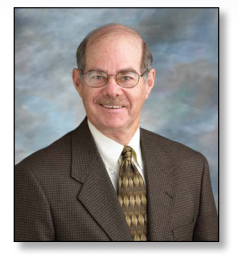
about $20,000. After seeing two different sales contracts implode for lack of buyer financing, she became so frustrated, she sold her home for $5,000 cash, says Ernst.
The owners of some 1.7 million older manufactured homes in the under-$20,000 price range may be in for the same rude awakening as the Kentucky woman when they try to sell their homes.
This is tied to other provisions in Dodd-Frank that are impacting both the industry and consumers.
Community banks that were once a source of chattel loans are getting out of the MH lending business, citing the cost and complexity of new regulations.
And behemoth U.S. Bank shocked the industry when it shuttered its indirect MH lending arm, citing “the limited market size and current regulatory environment.”
CFPB Director Richard Cordray last month told a Senate Banking Committee: “I don’t know what to make of some of the problems people are raising to me … because some of these lenders are quite profitable.”

The agency did not respond to a recent query asking how the profitability of “some” lenders, or even one lender, relates to consumer protection or consumer access to affordable home ownership — or how it compensates for shrinking opportunities to either buy or sell low-priced homes.
Ernst is puzzled by such a remark.
“Look at the mortgage companies — are they profitable? That’s why people are in business,” he says.
Those that are not, have stopped making the loans.

“I don’t think anyone meant to hurt our business with these laws,” says lawyer Sam Landy, President and CEO of UMH Properties, Inc., one of many manufactured home community operators who no longer offers financing through their subsidiary lending operation for MH buyers.
UMH had initiated $30 million in manufactured home loans in the past, offering residents who may have had less than stellar credit a path to home ownership in one of their dozens of communities.
Landy says UMH still sells homes, so long as they are third party financed, plus they do a booming business renting out the homes in their communities. But the absence of ‘second chance’ financing that UMH was making prior to CFPB imposed regulations has cost would-be buyers the opportunity to acquire equity, and cost UMH sales people commissions.
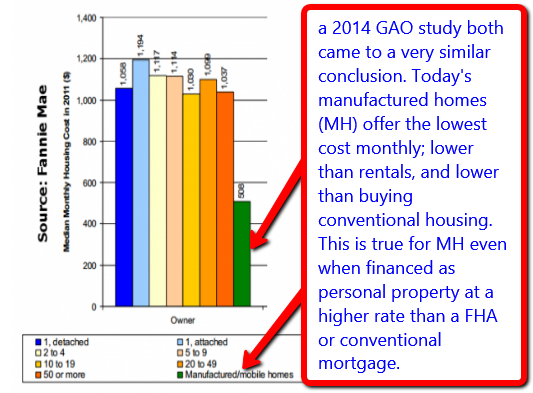
Seeking a Remedy
The pleas of industry leaders for regulatory relief have fallen on deaf ears at the CFPB, which is empowered to make or break the Dodd-Frank rules without Congressional oversight.
But Congress has begun to listen to the real-world consequences of good intentions gone awry and the billions of dollars in lending that has vanished from the MH market.
If poor financing practices brought the nation’s single-family home market to its knees, what will happen to the most affordable range of manufactured housing if people can’t obtain the financing to buy or sell those older, lower cost, under $20,000 homes?
The House of Representatives in April passed H.R. 650, the Preserving Access to Manufactured Housing Act, despite

staunch opposition from consumer groups and CFPB, the federal agency that is charged with protecting consumer interests.
Its companion in the Senate (S 682) is expected to come to the floor as part of another bill that is expected to be voted on in the coming months.
The legislation seeks to remedy the CFPB-imposed Dodd-Frank rules that have driven lenders from the under-$20,000 financing market, and to clarify the troublesome MLO provisions.
“All we want is a level playing field with the site-built real estate brokers and home builders who still have the ability to help their buyer find the best financing option for their situation,” says Glisson.
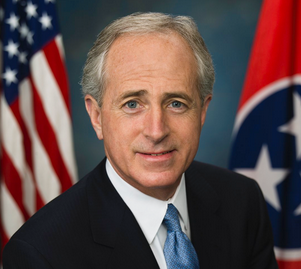
The measure is supported by various components of the MH industry, the National Association of Realtors, the Mortgage Bankers Association and others who view access to financing affordable housing as the motor that drives an important economic engine.
U.S. Senator Bob Corker, in last month’s Senate Banking Committee hearing, expressed his concern about the impact of Dodd-Frank on his low- to middle-income constituents in Tennessee, who have found their path to affordable home ownership blocked.
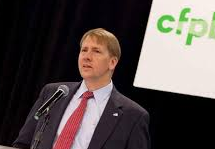
Rental housing opportunities in the rural communities are limited, he said, and rental fees everywhere cost more — sometimes significantly more — than the monthly payments on a manufactured home that could someday be their own.
“That doesn’t sound optimal from anybody’s standpoint,” Cordray responded.
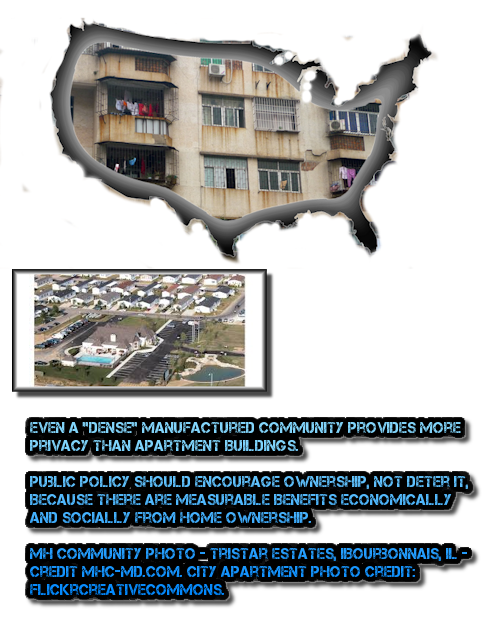
Meantime, the old farmer in Kentucky proved more persistent than most.
He found a salesman at another dealership willing to break the rules and help him fill out the blanks on his application. He is now the king of his castle — a brand new manufactured home with all the bells and whistles.
Sometimes a man’s gotta do what a man’s gotta do to make his dreams come true. ##

Editor’s Notes: Jan’s previous, related article about Dodd-Frank and manufactured home lending is linked below.
Links and illustrations for this column were supplied by MHLivingNews.com, not Jan Hollingsworth. The same is true for photos with quotes from various people about pending legislation, all found on The Hill – Capital Blog, found at the link below.
Regulations for Manufactured Home Loans
It should also be noted that conventional, on-site constructed housing lending is also impacted by the CFPB’s implementation of Dodd-Frank regulations. But the impact has arguably been greater on MH lending, as Hollingsworth’s research and reporting has demonstrated.
We will publish another featured article about non-lending, but eye opening, MH topic by Jan Hollingsworth in the days ahead. ##
 manufacturedhomelivingnews.com Manufactured Home Living News
manufacturedhomelivingnews.com Manufactured Home Living News
